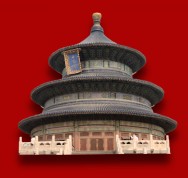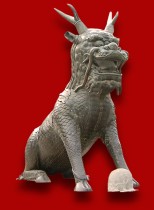

    |
 Day 1 - Wednesday 09th AprilDepart from London Heathrow to Beijing with Air China. Met by Ruth Lunn our excellent tour guide.Day 2 - Thursday 10th AprilArrive at Beijing Capital Airport. After clearing Customs and Immigration you will be met by Hubert (Sunshine) the China International Travel Service guide and transferred to the Jianshe Hotel for your overnight stay on a bed and breakfast basis. Dinner will be in the hotel followed by a Beijing by Night trip to see Tian An Men Square, the snack food street and the main shopping street. Much of the town is now lit at night in preparation for the 2008 Olympic games.
Day 3 - Friday 11th AprilAfter breakfast commence your sightseeing with visits to Tian An Men Square and the Forbidden City with lunch at the National Museum and shop.
This afternoon transfer to the airport for your flight to Chongqing (approx 2hrs). Upon arrival you will be taken to dinner at a local restaurant and gallery and then transferred to the pier to board your cruise vessel the MS Oriental Emperor for your three-nights down stream cruise to the dam project. The vessel sets sail at around 22.30hrs. The excellent Kitty provides the commentary on the Georges.
Day 4 - Saturday 12th AprilAt around 07.30hrs arrive in Fengdu, more popularly known as the "City of Ghosts" for your shore excursion. There is a temple in Fengdu dedicated to the God of Hades. Shopkeepers kept a basin of water into which customers threw their coins: if they sank they were genuine, but if they floated the coins were ghost money and were not accepted. Boats would moor in midstream rather than by the bank in case of attacks by ghosts. Today the town is thronged with tourists, attracted by temples and shrines dedicated to the gods of the underworld. The temple is reached by a chair lift to the top of the hill. There are a number of "tests" to perform. Return to your vessel and depart for the next part of your river journey.In the afternoon we take part in a short T'ai Chi demonstration by the onboard doctor. Day 5 - Sunday 13th AprilEnter the Qutang Gorge at 06:00hrs, although only five miles long it is probably the most fascinating and certainly the most beautiful. Here the Yangtse narrows to as little as 300 feet, the peaks rise upward of 3,700 feet: the water deepens, glistens and charges like molten lava: and the wind itself is flattened and funnelled through. As an ancient verse puts it, "Peaks pierce the sky as we course through the deep passage beneath." Arrive at Wushan at approx 08.00hrs and transfer to small boats for a ride along a small tributary of the Yangtse, which boasts magnificent smaller gorges - The Lesser Gorges. Monkeys can be seen on the banks and also the famous hanging coffins of the mysterious Bo people. On return to the boat, pass through the second of the Three Gorges, the Wu Xia, or Witches Gorge. Despite its name the 25 mile long Witches Gorge is relatively calm. As with so many places in China, the gorge, surrounded by twelve mountain peaks, are famed for their dark and sombre grace. Legend has it that crowned by the Goddess Peak, which has a likeness in stone of Yao Ji, youngest of the 12 daughters of the queen mother of the east. These 12 sisters stole away to Earth and met Yu the Great, tamer of floods, who was fighting the 12 dragons of the floodwaters. The sisters slayed the dragons and were eventually immortalised as the 12 peaks that assisted mariners in navigating Wu Gorge. Approaching the final of the three gorges, the Xiling Gorge, 48 miles long this gorge runs through slopes planted with orange groves. The gorge was once one of the most hazardous regions on the Yangtse, rife with rapids and whirlpools, but more than a hundred shoals and reefs have been dynamited in recent times, and the river is now lined with several thousand navigational buoys with all weather beacons. The vessel docks at the three gorges dam site. Day 6 - Monday 14th AprilDisembark the MS Oriental Emperor at around 08.00hrs and transfer by road for your sightseeing of the Three Gorges Dam Project. The new Three Gorges Dam consists of locks, silt-prevention dikes, silt-clearing sluices, spillways and power plants. When fully operational in 2009, it will raise the Mighty Yangtse to almost unimaginable heights. Visit the hilltop viewing platform followed by a visit to a local model explaining the dam project.Depart by road to Yichang seeing the remained of the Xiling Georg. A short visit to the local museum holding artefacts found whilst excavating the dam project. There is a chance here to purchase genuine antiques. Lunch at a local restaurant before transferring to the airport for the flight to Beijing (approx 2hrs). Upon arrival in Beijing you will be met and transferred to the Jianshe Hotel for your two-night stay. Dinner is at a local restaurant. Day 7 - Tuesday 15th AprilThe day will be spent visiting the Great Wall and the Summer Palace. There is a short stop at a fresh water pearl centre en route to the wall. The wall at this point has a height of 1619 steps before descending again. Afterwards lunch will be at a government friendship store where Beijing produces the famous Cloisonne technique pieces.
On return to the hotel there is an optional trip to see the Young Beijing Acrobats followed by dinner at a local restaurant. Day 8 - Wednesday 16th AprilEarly morning visit to the Temple of Heaven.
Visit to a silk factory to see the life cycle of a silk worm and how the thread is spun. Transfer to Beijing airport for your return flight back to London Heathrow.
|
 |
 |
 |